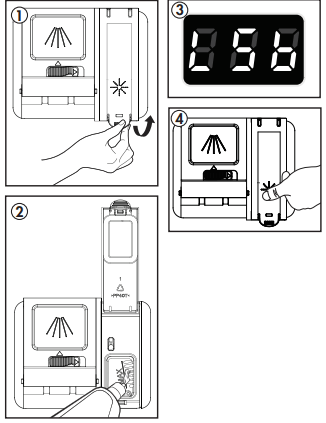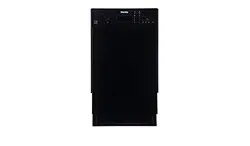Documents: Go to download!
User Manual
- User Manual - (English, French, Spanish)
- Energy Guide - (English)
- Product Specifications - (English)
- INSTALLATION INSTRUCTIONS
- OPERATING INSTRUCTIONS
- TROUBLESHOOTING
Table of contents
Use Manual Dishwasher
INSTALLATION INSTRUCTIONS
ACCESSORIES
- ST3.5*9 screws for the installation brace (x2)
- ST3.9*13 screws for the kick plate (x2)
- ST4*14 screws for the installation brace (x2)
- Condensation strip
- Installation brace (x2)
- Adjustment caps (x2)
- Kick plate
- Cable tie to secure the drain hose
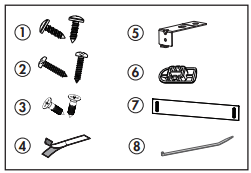
ENCLOSURE
The installation location must have a solid floor that is able to support the appliance when it is fully loaded and filled with water. The location must be within 9.8 feet (3 meters) of a sink with easy access to the water supply, the drain and an electrical outlet. The location must have enough space in front of it for the door to open to 90° so that the dishwasher can be loaded.
The installation enclosure should have the following dimensions: 17.7 inches (45 cm) wide by 32.5 inches (82.5 cm) tall by 22.8 inches (58 cm) deep. There should be less than 5 mm between the top of the dishwasher and the cabinet and the dishwasher door should align with the cabinet face.
If necessary, cut holes in the surrounding cabinetry to provide access the water and power connections.
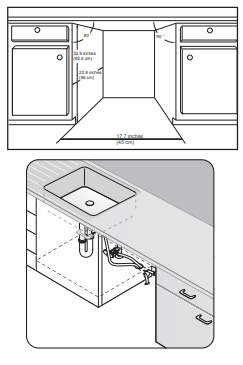
WATER CONNECTION INSTRUCTIONS
The hot water supply line pressure must be between 0.04 - 1 MPa.
The water supply inlet temperature should be between 48 - 65°C (120 - 149°F). Ensure that the water temperature does not exceed 65°C (149°F) to avoid damage to dishes.
Ensure that the circuit breaker and the water supply valve are turned off before connecting the hot water supply line to the dishwasher. The power cable will connect to the junction box on the front right side of the appliance. The hot water supply line will connect to the water port on the front left side of the appliance.
Note: It is recommended to only use soft water in the appliance to achieve the best washing results.
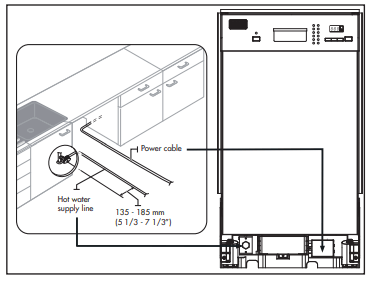
Connecting the hot water line
Run the hot water line through the channel on the bottom left side of the appliance. Make sure the hot water line is not twisted and then connect it to the appliance using an elbow joint. Use Teflon tape or sealing compound on the connection to avoid leaks. Do not over tighten the 90 ° elbow. This can damage the water inlet and cause a leak.
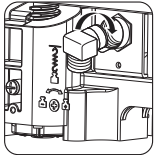
Connecting the drain line
The drain hose will connect to the drain pump on the bottom of the appliance. Run the drain line in the same channel on the bottom of the appliance as the hot water line. Ensure there is nothing inside the drain hose and that it does not tear during the installation process.
There are a number of different ways to connect the drain hose depending on the configuration of the sink. Review the different ways of connecting the drain system and choose a method that best suits the application. Local codes may require the installation of an air gap kit. Check with a qualified plumber if there is any doubt.
- Air gap
- Air gap with garbage disposal
- No air gap
- No air gap with garbage disposal
Use a rubber connector to connect drain hoses and hose clamps on all connection points.
Secure the drain hose to the sink wall using cable ties or other fastening materials. If not fastened, the drain hose may bend causing drainage problems.
The drain hose internal diameter is 0.8 inches (21 mm). The top of the drain hose must be less than 39 inches (100 cm) from the floor.
If the drain hose is not looped up the water may siphon out during a wash cycle. Any bends in the drain hose must be supported so that the hose will not kink or bend
 .
.
WIRING CONNECTION INSTRUCTIONS
Before connecting the power cable to the dishwasher, make sure the circuit breaker is off.
In the junction box located at the front bottom right of the dishwasher, find the three power wires from the dishwasher including the grounding line. Pass the power cable through the strain relief, and then into the junction box.
Connect the black wire of the dishwasher to the black wire of the power cable by inserting both into a wire nut and then rotating the wire connector. Connect the white wire to the white wire and the green to the green in the same manner.
Recheck each wire to ensure it is connected correctly and securely. Each colored wire should be connected to the corresponding wire of the same color. White should be connected to white, black to black, and green to green.
Replace the junction box cover on the dishwasher. Recheck each wire to ensure it is connected correctly and securely. Each coloured wire should be connected to the corresponding wire of the same colour.
WARNING ELECTRICAL SHOCK HAZARD
To avoid electrical shock, do not work on an energized circuit. Doing so could result in serious injury or death. To avoid a fire hazard, make sure electrical work is properly installed. Only qualified electricians should perform electrical work.
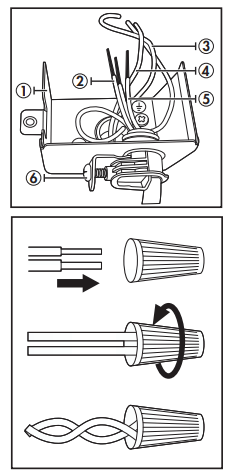
- Junction box
- Power cable
- Black to black
- White to white
- Green to green (ground to ground)
- Strain relief
LEVELING INSTRUCTIONS
Ensure that the appliance is level before placing it into the enclosure. The rear foot can be adjusted from the front of the dishwasher by turning. Use a flat screwdriver to adjust the front feet until the appliance is level.

INSTALLATION BRACES
The appliance must be secured in place with the installation braces. There are two different ways to use the braces.
A. Normal work surface
Put the installation hook into the slot of the side plane and secure it to the work surface with the wood screws.
B. Marble or granite counter top
Fix the side with the screw. Place the screw covers over the internal screws to protect them from water.
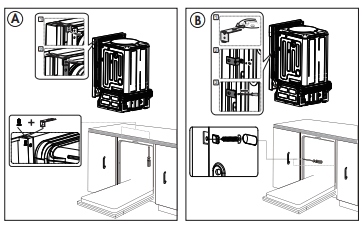
CONDENSATION STRIP
Attach the condensation strip under the work surface of the cabinet. Ensure that the strip is flush with the edge of the work surface.
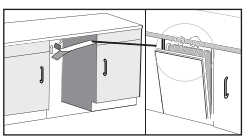
TOE KICK INSTALLATION
Install the toe kick on the bottom of the appliance.
[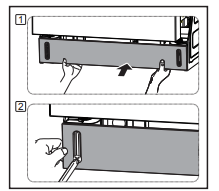
OPERATING INSTRUCTIONS
CONTROL PANEL

1. Power button: Use to turn the appliance on or off.
2. Handle
3. Programs: The light will illuminate to show which program has been selected.
A: Heavy wash
B: Normal wash
C: ECO wash
D: Glass wash
E: Rapid wash
F: Rinse
4. Features: The light will illuminate to show which features have been selected.
G: High temp wash - water temperature will be maintained at 60°C (140°F)
H: Heated dry - the heater will operate during the drying cycle
I: Sanitize - water temperature will be maintained at 69°C (156°F)
J: Rinse aid indicator light - light will illuminate when the rinse aid dispenser is empty
K: Cycle end indicator light - light will illuminate when the program is finished
L: Faucet warning indicator light - light will illuminate when the appliance is not receiving enough water; turn on the nearby water faucet to correct the water flow
5. Display screen: Shows the remaining running time in the current program.
6. Program button: Press to select the desired program.
7. Features button: Press to select the desired features.
8. Timed delay button: Press to set the desired time delay.
9. Start/Cancel button: Press to start the desired program. Press to cancel a program which it is in operation.
WASH CYCLE TABLE Press the program button to select the desired wash program.
Note: Cycle times are approximate and will vary based on the options selected.
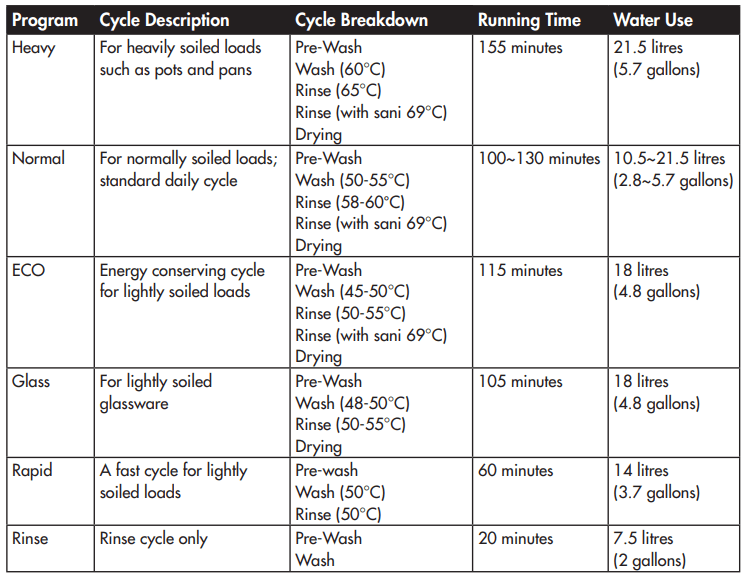
SMART WASH SYSTEM
This appliance is equipped with a Smart Wash System. When a partial load of lightly soiled dishes is placed in the appliance, a wash cycle similar to a short wash will automatically be performed.
When a full load of heavily soiled dishes is placed in the appliance, a heavy wash cycle will automatically be performed.
When a cycle is running, the remaining time could suddenly increase or drop several minutes. This indicates that the Smart Wash System has checked the soil level and determined in additional water fills are needed or if water fills can be deleted.
CHILD LOCK FUNCTION
Press and hold the features button and the time delay button for three seconds to engage the child lock function. The display screen will show a lock icon and the buttons on the control panel will not respond. Press and hold the features button and the time delay button for three seconds to disengage the child lock function.
LOADING THE DISHWASHER
- Scrape all dishes to remove any large food residue before placing in this appliance.
- Only place dishes in this appliance that are marked as dishwasher safe.
- Use a mild detergent.
Items that should not be placed in a dishwasher
- Cutlery with wooden, bone china or mother-of- pearl handles.
- Plastic items that are not heat resistant.
- Items that have been repaired with glue that is not heat resistant.
- Pewter, copper or steel items.
- Wooden platters.
- Items made from synthetic fibers.
- Items with glazed patterns may fade if machine washed frequently.
Tips for efficient loading
- Load hollow items such as cups, glasses or pans with the opening downward so that water cannot collect in the container.
- Items must not lie inside one another or cover one another.
- To avoid damage to glasses, they should not touch.
- Sharp items of cutlery such as carving knives should be loaded horizontally in the basket to avoid injury when unloading.
- Do not overload the appliance.
LOADING THE CUTLERY BASKET
Cutlery should be placed in the cutlery basket with the handles facing down. Ensure that cutlery items do not nest inside of one another as this can affect cleaning performance.
Sharp or pointed items should be placed in the cutlery basket with points facing down to avoid injury when unloading. Do not place excessively small items into the dishwasher as they could fall through the basket and impact the operation of the appliance.
LOADING THE UPPER BASKET
The upper basket is designed for cups, glasses, small plates, bowls and plastic items that are marked dishwasher safe. Make sure the loaded dishes do not interfere with the rotation of the spray arm located on the bottom of the upper basket.
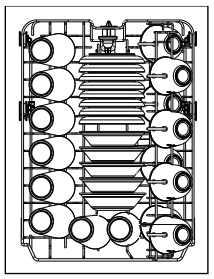
LOADING THE LOWER BASKET
The lower basket is designed for dinner dishes, soup bowls, plates, pots, lids, casserole dishes and plates. Load large items such as pans and pots should be loaded with their open sides facing downwards.
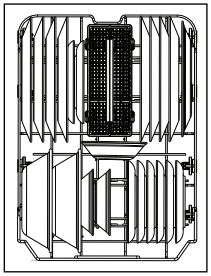
DETERGENT DISPENSER
The detergent dispenser must be filled before the start of each wash cycle. Add the detergent just before starting the wash cycle. Adding the detergent to the appliance too soon can cause it to become damp and it may not dissolve properly.
- If the detergent dispenser is closed, press the latch to open it.
- Add the recommended amount of detergent to the main detergent component.
- Close the flap by sliding it to the left and pressing down.

RINSE AID DISPENSER
Rinse aid can be used to prevent water droplets or streaks from forming on dishes. The rinse aid will be released automatically during the final rinse. This appliance is designed to use liquid rinse aid only. Do not use a powdered rinse aid as it will clog the reservoir opening. Do not put any other substance in the rinse aid dispenser as this can damage the appliance.
- Open the rinse aid dispenser by lifting the lid.
- Use the viewing port when filling the rinse aid reservoir. Do not fill the reservoir above the full level indicator.
- If the display screen shows “LSb”, the rinse aid dispenser is empty.
- Close the rinse aid cap by pressing down.
OPERATING INSTRUCTIONS
STARTING A WASH CYCLE
- Load the dishwasher as per the loading instructions.
- Add detergent and rinse aid as required.
- Close the dishwasher door and press the power button to turn on the appliance.
- Press the Program button repeatedly to choose the desired wash program. The programs will cycle in the following order: Heavy -> Normal -> ECO -> Glass -> Rapid -> Rinse
- Press the Options button to select the desired options.
- Run the hot water faucet nearest the appliance until the water is hot and then turn it off.
- Press the Start/Pause button to begin the cycle.
Note: When a wash program is finished the appliance will buzz 8 times and END will appear on the display screen.
ADDING A FORGOTTEN DISH
A forgotten dish can be added to a running cycle any time before the detergent dispenser has opened. If the detergent has already been released into the appliance, it is recommended not to add more dishes as they will not receive adequate cleaning.
To add a dish:
- Open door slightly and wait a few seconds until the wash action stops before completely opening.
- Add the forgotten item.
- Close the door firmly to latch within 4 seconds and the cycle will automatically resume.
Caution: Wait until wash action completely stops before opening the door. Hot water may splash out of the dishwasher and can cause injury.
CARE & MAINTENANCE
CLEANING
- After every wash, leave the door slightly open so that moisture and odors are not trapped inside the appliance.
- Only use a soft cloth and mild detergent to clean the appliance. Never use solvents or abrasive cleaning agents as this can damage the appliance.
- To remove water spots from the interior of the appliance, use a soft cloth dampened with a small amount of vinegar.
- If the appliance will not be used for a long period of time, it is recommended to run a normal wash cycle with the dishwasher empty and then leave the door open until the interior of the appliance is completely dry. This will help the door seals last longer and will help prevent odors from forming inside the appliance.
- Clean the door seals with a damp sponge regularly to prevent odors from food particles that can become trapped in the door seal.
FILTER SYSTEM
The filter system removes food particles from the wash water and traps them. It is highly recommended to empty and clean the filters after every wash cycle.
To clean the filter system:
- Turn off the dishwasher. Turn the filter and lift upwards to remove the filter system from the appliance.
- Rotate the filter insert counterclockwise to unfasten and then detach the filter insert.
- Rinse and clean the filters with water and replace them inside the appliance.

SPRAY ARM
The spray arm can be removed from the appliance by pulling gently upwards. Rinse the spray arm with warm water to remove any debris that can clog the nozzles. Replace the spray arm in the appliance by pushing downward until it clicks into place. Ensure that the spray arm movement is not impeded before running another cycle.

ERROR CODES
E1: Water intake is restricted or water pressure is too low.
E3: Malfunction of heating element
E4: Water overflow If the appliance displays any error code, a power reset may resolve the issue. Unplug the appliance, wait approximately 5 minutes and then plug the unit back in.
TROUBLESHOOTING
No power
- A fuse may be blown or the circuit breaker tripped
- Power surge
- Plug not fully inserted into the wall outlet
- Door not closed correctly
Water not drained from dishwasher
- Kink in drain hose
- Filter clogged
- Drain pump malfunction
Detergent left in the dispenser
- Dishes blocking dispenser from fully opening; unit may be over loaded
Suds left in the appliance
- Too much detergent or wrong kind of detergent
- Too much rinse aid
White film or cloudiness on dishes or interior tub
- Hard water minerals
- Too much detergent
- Not enough rinse aid
Noise inside the tub while running
- The spray arm is hitting an item in the basket
- An item has fallen out of the basket and is on the bottom of the wash tub
Dishes are not clean
- Dishes were loaded incorrectly
- The wash program was not powerful enough
- Not enough detergent
- Items are blocking the spray arm; unit may be over loaded
- Filter clogged
Dishes are not drying
- Dishes were loaded incorrectly
- Too many dishes were loaded
- Not enough rinse aid
- Dishes removed too quickly
See other models: DUFM085A2BSLDD DFF092C1WDB DAC250EB2WDB DBC93BLSDD DAC180BGUWDB
